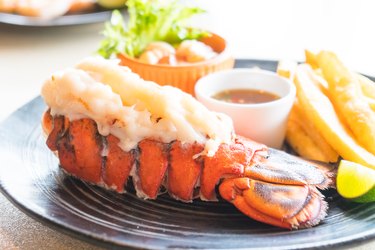
Ordering lobster from a restaurant is easy, but if you're preparing lobster at home, you'll develop a whole new appreciation for professional chefs and cooks everywhere.
If you're wondering how to cook lobster, you'll need to know how to tell if lobster is fully cooked, else you run the risk of serving under- or over-cooked seafood.
Video of the Day
Video of the Day
When cooking any type of seafood, you want to make sure it's cooked all the way through. To figure out once and for all the signs when lobster is done cooking, we spoke to Natalia Levey, a professional chef and restaurateur.
Signs Lobster Is Cooked
You'll be able to tell if lobster is fully cooked by checking the internal temperature with a meat thermometer. There are also physical signs to look for that will tell you when lobster is done cooking.
How long your lobster takes to cook depends on the size and cooking method. "The average lobster size people usually work with is a pound and a quarter. This will take approximately 9 to 12 minutes to boil or steam, depending on the size and freshness of the lobster and equipment used," Levey says.
"Think of boiling lobster like boiling pasta. The timer starts when you add the lobster to the pot of boiling water."
Safe Internal Temperature for Lobster
It's not possible to tell if food is safely cooked by relying on sight, smell and taste, according to the Academy of Nutrition and Dietetics.
When cooking any meat, the best way to determine if it's done cooking is using a food thermometer. This is the most accurate way to know when meat is thoroughly cooked to a safe internal temperature.
"The internal temperature of cooked lobster is 140 degrees Fahrenheit," Levey says. "Do not cook to a temperature higher than 140 F or the lobster can become tough and chewy."
What Cooked Lobster Looks Like
If you don't have a meat thermometer and must rely on your senses, Levey recommends looking for the following signs lobster is cooked:
- The shell will be bright red all over.
- Cooked lobster meat looks white, with the pink colors closest to the shell becoming a deep red.
- Just like with any protein (fish, chicken, beef, pork), as the lobster cooks, the protein will tighten and firm up.
When cooking steak, you may cut into the flesh to see if the inside is pink or red. It's the same with lobster. The flesh should be opaque, pearly white, according to FoodSafety.gov.
If you're waiting for fragrant aromas in the kitchen you're likely to keep waiting. When lobster is cooked, there is little to no odor, according to the FDA.
What Does Undercooked Lobster Look Like?
When you think of lobster, you likely imagine a bright red shell. But live lobsters don't start out this color. A live lobster has a green or black hue due to its different pigments.
But when it's fully cooked, all the other pigments (except red) won't show, according to the University of Maine. This is why the bright red color of a lobster is associated with it being fully cooked.
When lobster is undercooked, the color of the outer shell will still contain some green or black pigments, so the color is closer to that of a live, uncooked lobster.
"Uncooked lobster will appear translucent toward the center and light pink closest to the shell," Levey says. "It will be soft to the touch."
Risks of Eating Undercooked Lobster
It's important to ensure your lobster is fully cooked to prevent foodborne illnesses. Improperly prepared seafood and shellfish are associated with the following foodborne illnesses and diseases, according to the USDA:
- Salmonella
- Listeria monocytogenes
- Vibrio vulnificus
- Campylobacter jejuni
Vibrio bacteria species, which can affect lobster, can cause serious illnesses, especially in people with immune-compromising conditions, according to the University of Connecticut. Thoroughly cooking your lobster destroys this bacteria.
- FoodSafety.gov: “Safe Minimum Cooking Temperatures Chart”
- FDA: “Selecting and Serving Fresh and Frozen Seafood Safely”
- Academy of Nutrition and Dietetics: "A Short Guide to Food Thermometers"
- University of Maine: “Cooking & Eating a Lobster”
- USDA: “Foodborne Illness and Disease”
- University of Connecticut: “Seafood: Shellfish and Finfish”
- Lobster of Maine: Steamed or Boiled Lobster Preparation